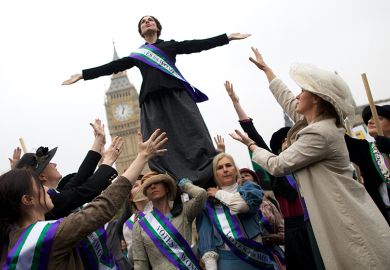Jeffrey Weeks finds a whole host of voices in a celebration of gay history.
Louis Crompton's book offers a thought that in a sense must structure all attempts at a historical understanding of homosexuality (and of sexuality in general): "The history of civilisation reveals, above all, how differently homosexuality has been perceived and judged at different times in different cultures." His majestic survey, stretching from the ancient Greeks and early Judea to Enlightenment Europe, taking in Imperial China and pre-Meiji Japan en route, does indeed show that the past is a different country. But it is also a past, he suggests, that continues to define us.
Crompton's book is truly the culmination of a lifetime's commitment. He helped, he tells us, to organise a university course on homosexuality in 1970, on the crest of the first wave of gay liberation, and had to endure a legislative attempt to ban discussion of homosexuality outside the state medical school. The attempt failed, but the course was not repeated. His history, then, is one of a living awareness of the time when homosexuality, almost 100 years after Oscar Wilde offered the description, was still the love that dare not speak its name, at least in the classroom. Writing a history of homosexuality is therefore a mission to remind the reader of millennia of oppression and resistance. For Crompton, the commonalities of that disparate history of homosexuality lie in two elements: the fact of common sexual practices, and the possibilities of human love and devotion that survived and contested all that history ("their" history) could throw at it. His history is, in part at least, a history of celebration.
Matt Cook's book is a product of a different world, a different time, a different culture and a different urgency. Based on his PhD (on a topic that would have been virtually impossible in 1970), it builds on 30 years of ever-deepening scholarship around the subject and an ever-increasing theoretical sophistication. The book draws on literary scholarship as well as lesbian, gay or queer theory. It deploys urban geography as easily as the new social history. Cook does not have to prove the value of the topic.
He can deploy it to bring to life a moment of history on the cusp of radical change.
Cook is not so much interested in the longue durée of homosexual history as the complex ways in which "homosexuality was woven into the fabric of urban cultures" in the period from 1885, when the Labouchere Amendment to the Criminal Law Amendment Act criminalised all forms of male homosexual behaviour, in private and in public, to the outbreak of the First World War: a decisive period in British - and Western - homosexual history. Where Crompton rejects the suggestion by Michel Foucault that the late 19th century marked a real rupture in the history of homosexuality, with the emergence of "the homosexual" as a species being, Cook locates his exploration precisely in this period. He does not univocally accept Foucault: men were still being berated in the 1890s, he argues, for what they had done rather than what they were. "Homosexuals" were still not commonly seen as belonging to a species, the Other of a great binary divide, set apart by biology, character, the ability to whistle, or whatever. But he is interested in a rather different question: not so much what the homosexual was or did or became, but how homosexuality was still experienced as a diverse set of meanings and practices, across the spaces and in the interstices of a vibrant, anonymous, bursting, complicated and differentiated urban life.
For Crompton, the history of homosexuality is the history of an emerging unity. For Cook, it is more like a history of difference. For the older scholar, the task is to reveal a history that has been denied. For the younger historian it is the very indistinctiveness of the categories of homosexual/invert/ pervert/Maryanne that is the problem. The neat categories of the sexologists, who in the late 19th century were just honing their craft, and of the gay historian, who from the 1970s sought to establish the lineaments of a common history, crumble when you look at the urban melange.
Cook's book strongly evokes two major works that have sought to dissolve the certainties and elucidate the resonances of late 19th and early 20th-century sexual history. In City of Dreadful Delight (1992), Judith Walkowitz brilliantly analysed the narratives of sexual danger in a London that was home to Jack the Ripper and to radical intellectuals cogitating on the meaning and future of sex, that could be swept by moral panics on prostitution and the exploitation of young girls, and could glory with the cheap press at the downfall of Wilde. George Chauncey's Gay New York (1995) is a compelling portrait of the making of the gay male world from the 1890s to the 1940s. This landmark in gay history shows both how sexual identities are made and how they are always provisional, in process, subject to the changing pushes and pulls, possibilities and limitations of a society where who and what you are, what your sexuality is, matters, but matters in different ways at different places and times.
Cook's London is similarly a world of danger and of possibility, of new meanings and old patterns. It is a world of complexly overlapping, intertwining but differentiated sexual cultures. It is a world where homosexuality can be encountered in trains, Tube stations, theatres, streets, music halls, public houses, squares, Turkish baths, urinals, parks, cafés, gentlemen's clubs, settlement houses, churches, hotels, shops and barracks, and yet be totally illegal. It is not so much that, as the early gay liberation slogan suggested, "we are everywhere" - it is more that the "we" was still emergent, fractured into a hundred different experiences, a retrospective invention. So the figures that appear in this study are varied, and not easily mapped on to the sexological categories that were just then appearing in the writings of Richard Krafft-Ebing, Havelock Ellis, Magnus Hirschfeld and many others. They are familiar urban types: the dandy, the bachelor, the Bohemian, the theatregoer, the settlement worker, the soldier, the telegraph boy, the clubman, the priest, as well as the male prostitute, the playwright and the campaigner. This was a world of friendships and of casual sexual encounters, of high-minded philosophising about the nature of love, and of low-life encounters. It was a society where many of the old boundaries were dissolving in the maelstrom of the great world city, and new boundaries were being drawn.
This was the city as Sodom, the city of the Plain, the new Babylon, where vice and virtue lived side by side, and aristocrats, telegraph boys, cross-dressers and male prostitutes met each other in parks or streets or brothels, and encountered their nemesis in courts or in the press, and somehow survived. This was the city, like those other great metropolises such as Berlin, Paris, Vienna and New York, that the new scientists of sex, the first generation of sexologists, had as their laboratories for discovering (or inventing) the new sexual types that were to walk out of the textbooks into the history books in the 20th century. This was the city where early reformers such as the criminologist George Ives founded secretive campaigning groups, named in honour of ancient Greeks, that were, in a convoluted way, to become the precursors of campaigning groups of the next century. This was the home of transgressive radicalism and of Hellenic romanticism, of impassioned polemics à la Wilde, and of George Ives' lifelong commitment to "the cause", kept alive for posterity in a multimillion-word encoded diary.
All this was part of a wider struggle over the meanings of gender and sexuality. Homosexuality is so important as a historical theme in the 19th century not only because a sizeable minority lived it in diverse ways but because it was a major battleground on which 20th-century concepts of masculinity and femininity and of sexual identities were forged. W. T. Stead, the radical journalist whose campaigns in the 1880s opened the way for the Criminal Law Amendment Act of 1885, lamented the fall of Wilde because it would inhibit friendships between men. By the mid-20th century, the embryonic categorisations we can see emerging in London in the 1880s and 1890s had become categorical. The diversity that Cook explores had been not so much obliterated as obscured. Homosexuality had become the inferiorised Other.
It is that Otherness that Crompton's book explores. Cook goes rather further: he deconstructs the categories and, in doing so, demonstrates that there is not so much a history of (homo)sexuality as multiple histories.
Crompton seeks a sense of brotherhood or sisterhood across the aeons of time. Cook reminds us that we can raise a gesture of solidarity across the generations. But we must never forget that they did things differently then.
Jeffrey Weeks is professor of sociology, London South Bank University.
Homosexuality and Civilization
Author - Louis Crompton
Publisher - Harvard University Press
Pages - 623
Price - £22.95
ISBN - 0 674 01197 X
Register to continue
Why register?
- Registration is free and only takes a moment
- Once registered, you can read 3 articles a month
- Sign up for our newsletter
Subscribe
Or subscribe for unlimited access to:
- Unlimited access to news, views, insights & reviews
- Digital editions
- Digital access to THE’s university and college rankings analysis
Already registered or a current subscriber?



